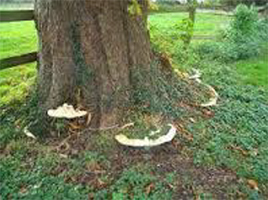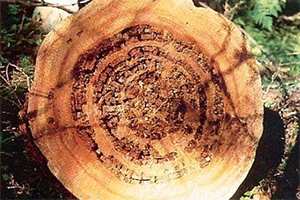HOST PLANTS:
All tree species are susceptible to wood decay but some are more resistant to decay than others.![]()
DAMAGE:
Wood decay affects both heartwood and sapwood in the roots, butt, main stem or main branch unions of large trees. Lawn equipment, improper pruning, animals, storm breaks and other factors can cause injuries that lead to decay. Not all wounds lead to wood decay. Decay begins when the chemical wall of defense is broken by decay organisms which decompose the wood tissue causing wood decay. Decay is often hidden behind narrow bands of seemingly healthy sapwood and bark. Fruiting bodies may appear when decay is close to the bark surface. These can be fleshy mushrooms that fall off shortly after they appear, or they may be woody conks that stay in place for many years. Removal of the fruiting body does not stop the spread of decay. Their presence allows the causal pathogen to be identified, helping arborists to assess the damage.
DESCRIPTION AND CAUSE:
Wood decay is a process of wood disintegration that is caused by fungi or other micro-organisms. Decay can occur in any infected woody part of a tree. The process begins through wounds, where the wood becomes exposed. Many species of fungi cause wood decay. Most of them produce characteristic types of fruiting bodies known as conks or mushrooms. Presence of conks and mushrooms indicates advanced decay inside the tree. In the urban environment, these trees can be hazardous and need to be managed appropriately. A healthy tree can wall off infection and decay in a process called “compartmentalization of decay in trees” (CODIT).
CONTROL MEASURES:
Avoid injuring trees. Do not fill cavities as this may promote and hide decay. Tree paint on cuts and wounds is not a good practice and has been found to actually encourage decay. Avoid unnecessary pruning. Prune to develop healthy branch and crown form while the tree is young, thus avoiding radical corrective pruning later. Follow appropriate specifications for construction in close proximity to trees. Get professional advice, to prevent injury.



Reference: City of Toronto Website; Threats to Trees
